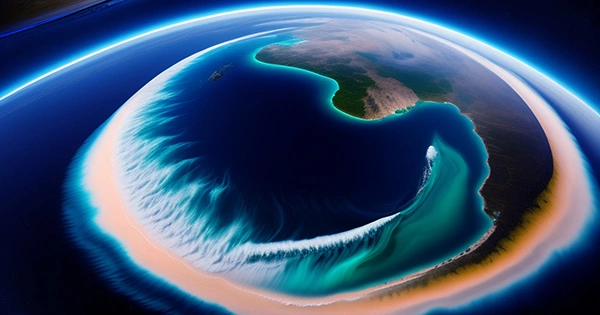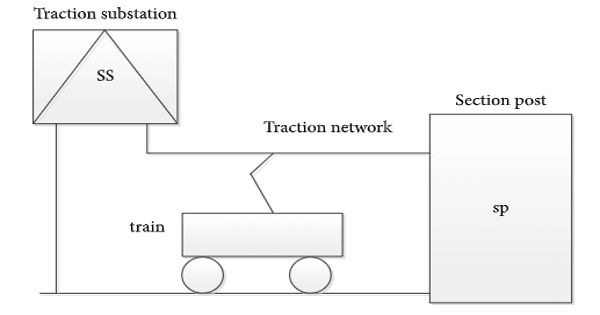The Indian Ocean has a “gravity hole” – a location where the Earth’s gravitational attraction is weaker, its mass is lower than normal, and the sea level drops by more than 328 feet (100 meters).
This anomaly has long perplexed geologists, but now researchers from the Indian Institute of Science in Bengaluru, India, believe they have discovered a plausible explanation for its formation: plumes of magma coming from deep within the planet, similar to those that lead to the formation of volcanoes.
The scientists employed supercomputers to recreate the formation of the region up to 140 million years ago in order to arrive at this theory. The results, described in a paper just released in the journal Geophysical Research Letters, center on an extinct ancient ocean.
A vanishing ocean: Humans are accustomed to viewing the Earth as perfectly spherical, yet this is not the case.
“The Earth is basically a lumpy potato,” said research coauthor Attreyee Ghosh, a geophysicist and associate professor at the Indian Institute of Science’s Centre for Earth Sciences. “Technically, it’s not a sphere, but an ellipsoid, because the middle part bulges outward as the planet rotates.”

The density and physical characteristics of our planet are not uniform, with certain regions being denser than others; this has an impact on the Earth’s surface and gravity, said Ghosh. “If you pour water on the Earth’s surface, the level it takes is referred to as a geoid, and that is controlled by these density differences in the material inside the planet,” she added. “They attract the surface in very different ways depending on how much mass there is underneath.”
The “gravity hole” in the Indian Ocean, also known as the Indian Ocean geoid low, is the geoid’s lowest point and largest gravitational anomaly, forming a circular depression that begins just off the southern tip of India and spans approximately 1.2 million square miles (3 million square kilometers). During a gravity survey from a ship in 1948, Dutch geophysicist Felix Andries Vening Meinesz stumbled upon the anomaly, which has since remained a mystery.
“It is by far the biggest low in the geoid, and it hasn’t been explained properly,” Ghosh added.
Ghosh and her colleagues utilized computer models to turn the clock back 140 million years in order to see the larger picture geologically. “We have some information and confidence about what the Earth looked like back then,” she explained. “The continents and oceans were located in very different places, and the density structure was also very different.”
The scientists then used that as a starting point for 19 simulations that continued up to the present, simulating tectonic plate movement and the behavior of magma, or molten rock, inside the mantle, the substantial layer of the Earth’s interior that sits between the core and the crust. A geoid low resembling the one in the Indian Ocean formed in six of the scenarios.
The presence of magma plumes near the geoid low, which together with nearby mantle structures are thought to be responsible for the formation of the “gravity hole,” was what set apart all six of these models, according to Ghosh. The models were done with various magma density estimates, and the low did not occur in those where the plumes were not present.
Ghosh explained that the plumes arose from the disappearance of an ancient ocean when India’s landmass migrated and eventually clashed with Asia tens of millions of years ago.
“140 million years ago, India was in a very different place, and there was an ocean between the Indian plate and Asia.” “As India moved north, the ocean disappeared and the gap with Asia closed,” she stated. As the oceanic plate descended into the mantle, it may have accelerated the development of plumes, bringing low-density material closer to the Earth’s surface.
The future of the geoid low: According to the team’s calculations, the geoid low developed roughly 20 million years ago. It’s difficult to predict whether it will ever go away or disappear.
“That all depends on how these mass anomalies in the Earth move around,” Ghosh explained. “It’s possible that it will last a long time.” However, it is possible that plate movements would function in such a way that it will vanish a few hundreds of millions of years in the future.”
Huw Davies, a professor at Cardiff University’s School of Earth and Environmental Sciences, said the study is “certainly interesting, and describes interesting hypotheses, which should encourage further work on this topic.” Davies was not involved in the research.
Dr. Alessandro Forte, a geology professor at the University of Florida in Gainesville who was not involved in the study, believes that there are good reasons to conduct computer simulations to determine the origin of the Indian Ocean geoid low and that this study is an improvement over previous ones. Previous studies only simulated the descent of cold material over the mantle, not heated rising mantle plumes.
However, Forte stated that he discovered a few faults in the study’s execution.
“The most striking problem with the authors’ modeling strategy is that it completely fails to reproduce the powerful mantle dynamic plume that erupted 65 million years ago beneath the current location of Réunion Island,” he said. “A powerful mantle plume that is completely absent from the model simulation has long been attributed to the eruption of lava flows that covered half of the Indian subcontinent at this time, producing the celebrated Deccan Traps, one of the largest volcanic features on Earth.”
Another difficulty, according to Forte, is the disparity between the anticipated geoid, or surface shape, and the actual one: “These differences are especially noticeable in the Pacific Ocean, Africa, and Eurasia.” The authors cite a moderate correlation (about 80%) between predicted and observed geoids, but they do not provide a more specific estimate of how well they match numerically (in the study). This discrepancy shows that the computer simulation may have flaws.”
According to Ghosh, the simulations cannot account for every possible aspect.
“That’s because we don’t know what the Earth looked like in the past with absolute certainty.” The further back in time you go, the less confident the models get. “We can’t account for every possible scenario, and we also have to accept that there may be some discrepancies in how the plates moved over time,” she explained. “But we believe the overall reason for this low is quite clear.”
















